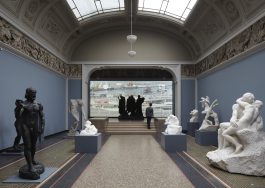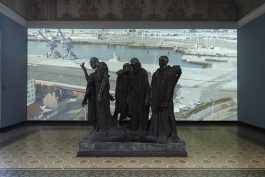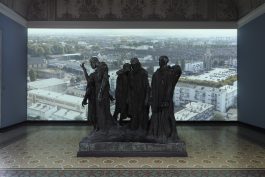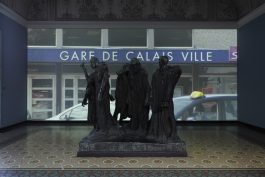Calais es una obra de vídeo y sonido creada para el dramático grupo escultórico “Los burgueses de Calais”, de Augusto Rodin (en la Nueva Gliptoteca Carlsberg de Copenhague).
“Los burgueses de Calais” es una interpretación de la leyenda sobre los seis ciudadanos que en 1347, durante asedio inglés, se ofrecieron para ser sacrificados y salvar así al resto de ciudadanos de Calais. Otra versión de la historia cuenta que no eran seis de los mejores vecinos de la villa, sino condenados que, en cualquier caso, iban a ser ejecutados. Ya fueran víctimas o paladines, la escultura no muestra héroes canónicos, sino seis hombres demacrados, aterrorizados por la suerte a la que se enfrentan.
En su obra, Eva Koch ha elegido traer la ciudad de Calais a este grupo exiliado de ciudadanos, y ha filmado la ciudad tal y como está hoy: una ciudad marcada por el desempleo y problemas por el creciente número de inmigrantes ilegales que todos los días cruzan el Eurotúnel. El vídeo muestra el día a día de la ciudad, pero se centra principalmente en el tráfico, coches, el tren y los transbordadores que unen Calais con el resto del mundo. Con el enfoque en el movimiento perpetuo de un lugar a otro de los hombres, la obra conecta con una amplia gama de trabajos anteriores de Eva Koch que gira en torno al hombre nómada moderno, como una criatura que siempre, física y mentalmente, está en marcha. Por deseo, pero también por necesidad, tal y como sucede precisamente en el grupo de viajeros que parten y llegan a Calais.
La escultura de Rodin fue, en su día, polémica e innovadora, y con su instalación Eva Koch se permite el lujo de unirse a la serie de artistas que no construye más sobre lo ya conocido, sino que abre nuevos caminos. La instalación Calais demuestra que luz y sonido son materiales al mismo nivel que el bronce, el yeso y el mármol, y que aunque las formas de expresión artística, por suerte y por necesidad, cambian con el tiempo, el arte continúa teniendo abierta la misma pregunta existencial.




